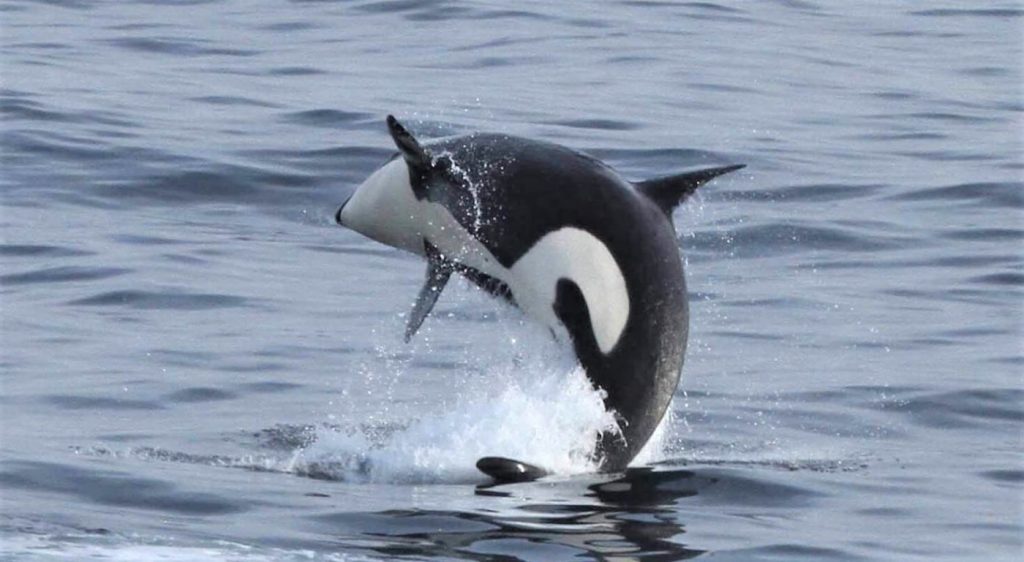Each spring gray whales migrate north from Mexico, towing their newborn calves over the formidable Monterey Canyon for the first time. Orcas also come into the bay. to hunt the baby grays.
Now local scientists are following the “flukeprints” orcas leave behind to find clues about their health and identity.
Related Articles
Scientists say they are learning basics of sperm whale language
White orca Frosty, now 4, spotted off California with transient pod CA216
Whale found off East Bay coast likely died after being hit by ship
Season’s first blue whale does ‘greyhounding lunges’ off California coast
Dead gray whale washes up on East Bay beach
While there’s always a chance of seeing killer whales in Monterey Bay, researchers notice a slight uptick in sightings during the gray whale migration in April and May. This year, the California Killer Whale Project is partnering with Ocean Wise, a conservation nonprofit based in Vancouver, British Columbia. The researchers, self-dubbed “orca-holics,” are collaborating to try out a new technique to study the orcas. Their goal is to use eDNA, or tiny bits of DNA found in the environment, to learn more about the 200 individuals in the local population. This method has never been used before to study the skin microbiome of marine mammals.
Over the next few months, they will brave the spring wind on Monterey Bay to collect as many biological samples as they can. Their sample analysis in the fall will determine whether this strategy can replace or supplement the standard, much more invasive procedure of blubber biopsy.
For conservationists, killer whales are a triple threat. Socially, they are essential to indigenous communities’ culture, traditions and practices. In the environment, they are essential top-down predators that also contribute to the carbon cycle, which helps maintain the climate. Economically, whale-watching is an entire industry of jobs that fully relies on a healthy population.
Like humans, orcas shed cells everywhere they go. These DNA fragments, known as eDNA, can tell us about their whereabouts, relationships to each other, and even their health.
Ocean Wise Research Technician Gary Sutton explained the collection process is quite simple. “You wait until they dive, and then sample that flat patch of water called the flukeprint, where you can find skin cells. Scoop it up, run it through a machine, and see if we can find out what bacteria live on the skin of whales, which is a good indication of the overall health of the animal,” said Sutton.
In order to control for the dynamic currents, they sample nearby seawater, outside of the whale’s flukeprint. This establishes a baseline for comparison.
After they collect the samples, Killer Whale Project researchers send them to the Ocean Wise Environmental DNA lab in Vancouver. They run the samples through PCR analysis, which allows them to search for specific species. “We can set the primers in our analysis process to look for bacteria on killer whales rather than, you know, salmon,” said Sutton.
Then, they can look at which bacteria and other microorganisms are associated with different whales. Usually, to find out if individuals are healthy or who is related to whom, scientists have to biopsy live whales, which involves using a crossbow dart to take a small chunk of their skin. If it works, eDNA analysis would be a far less invasive way to get much of the same information.
While orcas are not small — even their calves can weigh 400 pounds — Monterey Bay is roughly the size of Connecticut. Killer Whale Project biologist Colleen Talty says that even during the spring surge, the orcas are hard to find. For the past few years, their favorite food source has been suffering an unusual mortality event. The gray whale population has been on the decline since 2019, so orcas might be seeking alternative prey.
“Fewer calves means less of that particular food source for the killer whales, so they could be traveling in different areas to attack different species or dolphins or even attacking gray whale calves in different areas,” said Talty.
Killer whales have plenty of other food sources, but if they bail on the bay to find food elsewhere, they will be even harder to find and study.
After a training period with Ocean Wise, the Killer Whale Project team has collected six samples. They hope to collect at least 20 more before analysis in September.
Dr. Chloe Robinson, Director of the Ocean Wise Whales initiative, has done similar studies filtering out bacteria from eDNA in dolphin breath. She is confident in this technique. “I think it has about 99% chance of succeeding,” said Robinson, “And even if a handful of samples work, then that’s still a success.”
Overall, this joint research venture could be a new way to study orcas in their natural habitat, and better understanding leads to better protection.
“Orcas are important socially, economically, and biologically,” said Robinson, “But more than anything, they are a highly intelligent and emotional species that deserves to be protected.”


